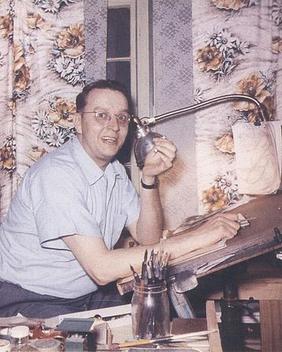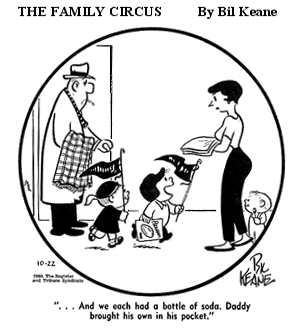A comic strip is a sequence of cartoons, arranged in interrelated panels to display brief humor or form a narrative, often serialized, with text in balloons and captions. Traditionally, throughout the 20th and into the 21st century, these have been published in newspapers and magazines, with daily horizontal strips printed in black-and-white in newspapers, while Sunday papers offered longer sequences in special color comics sections. With the advent of the internet, online comic strips began to appear as webcomics.

A cartoon is a type of visual art that is typically drawn, frequently animated, in an unrealistic or semi-realistic style. The specific meaning has evolved, but the modern usage usually refers to either: an image or series of images intended for satire, caricature, or humor; or a motion picture that relies on a sequence of illustrations for its animation. Someone who creates cartoons in the first sense is called a cartoonist, and in the second sense they are usually called an animator.

Jack Ralph Cole was an American cartoonist best known for birthing the comedic superhero Plastic Man, and his cartoons for Playboy magazine.

The Far Side is a single-panel comic created by Gary Larson and syndicated by Chronicle Features and then Universal Press Syndicate, which ran from December 31, 1979, to January 1, 1995. Its surrealistic humor is often based on uncomfortable social situations, improbable events, an anthropomorphic view of the world, logical fallacies, impending bizarre disasters, references to proverbs, or the search for meaning in life. Larson's frequent use of animals and nature in the comic is popularly attributed to his background in biology. The Far Side was ultimately carried by more than 1,900 daily newspapers, translated into 17 languages, and collected into calendars, greeting cards, and 23 compilation books, and reruns are still carried in many newspapers. After a 25-year hiatus, in July 2020 Larson began drawing new Far Side strips offered through the comic's official website.

The Family Circus is a syndicated comic strip created by cartoonist Bil Keane and, since Keane's death in 2011, is written, inked and rendered (colored) by his son Jeff Keane. The strip generally uses a single captioned panel with a round border, hence the original name of the series, which was changed following objections from the magazine Family Circle. The series debuted on February 29, 1960 and has been in continuous production ever since. According to publisher King Features Syndicate, it is the most widely syndicated cartoon panel in the world, appearing in 1,500 newspapers. Compilations of Family Circus comic strips have sold more than 13 million copies worldwide.
George Booth was an American cartoonist who worked for The New Yorker magazine. His cartoons usually featured an older everyman, everywoman, or everycouple beset by modern complexity, perplexing each other, or interacting with cats and dogs.

Virgil Franklin Partch, who generally signed his work Vip, was an American gag cartoonist. His work appeared in magazines of the 1940s and 1950s, and he created the newspaper comic strips Big George and The Captain's Gig. He published 19 books of illustrations and drew art for children's books.
A daily strip is a newspaper comic strip format, appearing on weekdays, Monday through Saturday, as contrasted with a Sunday strip, which typically only appears on Sundays. They typically are smaller, 3–4 grids compared to the full page Sunday strip and are black and white.

James Guilford Swinnerton was an American cartoonist and a landscape painter of the Southwest deserts. He was known as Jimmy to some and Swinny to others. He signed some of his early cartoons Swin, and on one ephemeral comic strip he used Guilford as his signature. Experimenting with narrative continuity, he played a key role in developing the comic strip at the end of the 19th century.

Harry Bliss is an American cartoonist and illustrator. Bliss has illustrated many books, and produced hundreds of cartoons and 25 covers for The New Yorker. Bliss has a syndicated single-panel comic titled Bliss. Bliss is syndicated through Tribune Content Agency and appears in over 80 newspapers in the United States, Canada and Japan.

The Little King is an American gag-a-day comic strip created by Otto Soglow, which ran from 1930 to 1975. Its stories are told in a style using images and very few words, as in pantomime.

William Pierce Hoest was an American cartoonist best known as the creator of the gag panel series, The Lockhorns, distributed by King Features Syndicate to 500 newspapers in 23 countries, and Laugh Parade for Parade. He also created other syndicated strips and panels for King Features.
Liō is a daily comic strip created by American artist Mark Tatulli and distributed by Universal Press Syndicate/Universal Uclick/Andrews McMeel Syndication since May 15, 2006. As a pantomime strip, it has an international appeal. In 2008, the strip brought Tatulli a National Cartoonists Society Newspaper Comic Strip Award.

Out Our Way was an American single-panel comic strip series by Canadian-American comic strip artist J. R. Williams. Distributed by Newspaper Enterprise Association, the cartoon series was noted for its depiction of American rural life and the various activities and regular routines of families in small towns. The panel introduced a cast of continuing characters, including the cowboy Curly and ranch bookkeeper Wes. Out Our Way ran from 1922 to 1977, at its peak appearing in more than 700 newspapers.

Life's Like That was a gag panel by Fred Neher which found humor in life's foibles. Spanning five decades -- from October 1, 1934 to August 20, 1977 — the panel was initially distributed by Consolidated News Features, and later by the Bell-McClure Syndicate and the United Feature Syndicate.

Leo Aloysius Cullum was an American cartoonist, one of the more frequent contributors to The New Yorker with more than 800 gag cartoons published. He started his drawing career after having served as a pilot in the United States Marine Corps during the Vietnam War and flying planes commercially for Trans World Airlines and American Airlines.

Stan Fine, was an American gag cartoonist. He contributed to major magazines, signed his work with his full name but sometimes reversed his last name to submit cartoons under the signature Enif.
Comics has developed specialized terminology. Several attempts have been made to formalize and define the terminology of comics by authors such as Will Eisner, Scott McCloud, R. C. Harvey and Dylan Horrocks. Much of the terminology in English is under dispute, so this page will list and describe the most common terms used in comics.
Hilary B. Price is an American cartoonist. She is known for creating the comic strip Rhymes with Orange, which is published digitally on her website and in over one hundred newspapers across the United States. At the age of 25 she became the youngest cartoonist to ever be nationally syndicated. She won the Silver Reuben for "Best Newspaper Panel Cartoon" from the National Cartoonists Society four times, in 2007, 2009, 2012, and 2014.












